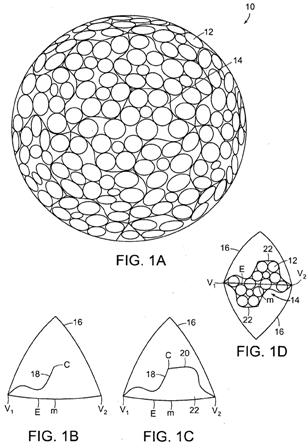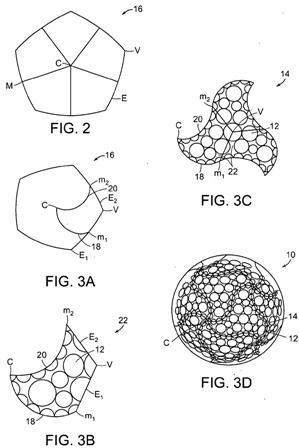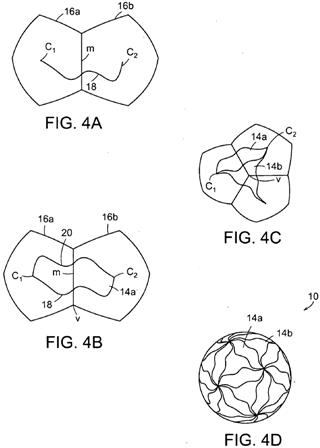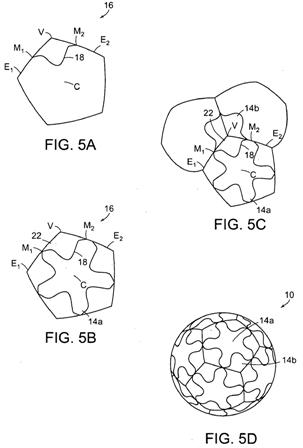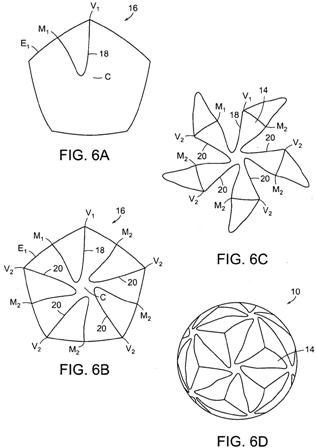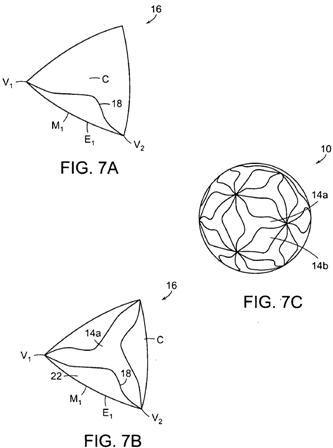Dimples, Amazing Dimples; I Hope Your Domains Are Tessellated
Can you ever get enough information regarding golf ball aerodynamics? OK, maybe some people can, but not the readers of this blog. Check out this new Acushnet design.
The drawings come from a recently published patent application titled “Dimple Patterns for Golf Balls” (US Pub. No. 20100113187). The application explains:
The present invention provides a method for arranging dimples on a golf ball surface that significantly improves aerodynamic symmetry and minimizes parting line visibility by arranging the dimples in a pattern derived from at least one irregular domain generated from a regular or non-regular polyhedron. The method includes choosing control points of a polyhedron, generating an irregular domain based on those control points, packing the irregular domain with dimples, and tessellating the irregular domain to cover the surface of the golf ball. The control points include the center of a polyhedral face, a vertex of the polyhedron, a midpoint or other point on an edge of the polyhedron and others. The method ensures that the symmetry of the underlying polyhedron is preserved while eliminating great circles due to parting lines.
[0001] This invention relates to golf balls, particularly to golf balls having improved dimple patterns. More particularly, the invention relates to methods of arranging dimples on a golf ball by generating irregular domains based on polyhedrons, packing the irregular domains with dimples, and tessellating the domains onto the surface of the golf ball.BACKGROUND OF THE INVENTION
[0002] Historically, dimple patterns for golf balls have had a variety of geometric shapes, patterns, and configurations. Primarily, patterns are laid out in order to provide desired performance characteristics based on the particular ball construction, material attributes, and player characteristics influencing the ball’s initial launch angle and spin conditions. Therefore, pattern development is a secondary design step that is used to achieve the appropriate aerodynamic behavior, thereby tailoring ball flight characteristics and performance.
[0003] Aerodynamic forces generated by a ball in flight are a result of its velocity and spin. These forces can be represented by a lift force and a drag force. Lift force is perpendicular to the direction of flight and is a result of air velocity differences above and below the rotating ball. This phenomenon is attributed to Magnus, who described it in 1853 after studying the aerodynamic forces on spinning spheres and cylinders, and is described by Bernoulli’s Equation, a simplification of the first law of thermodynamics. Bernoulli’s equation relates pressure and velocity where pressure is inversely proportional to the square of velocity. The velocity differential, due to faster moving air on top and slower moving air on the bottom, results in lower air pressure on top and an upward directed force on the ball.
[0004] Drag is opposite in sense to the direction of flight and orthogonal to lift. The drag force on a ball is attributed to parasitic drag forces, which consist of pressure drag and viscous or skin friction drag. A sphere is a bluff body, which is an inefficient aerodynamic shape. As a result, the accelerating flow field around the ball causes a large pressure differential with high-pressure forward and low-pressure behind the ball. The low pressure area behind the ball is also known as the wake. In order to minimize pressure drag, dimples provide a means to energize the flow field and delay the separation of flow, or reduce the wake region behind the ball. Skin friction is a viscous effect residing close to the surface of the ball within the boundary layer.
[0005] The industry has seen many efforts to maximize the aerodynamics of golf balls, through dimple disturbance and other methods, though they are closely controlled by golf’s national governing body, the United States Golf Association (U.S.G.A.). One U.S.G.A. requirement is that golf balls have aerodynamic symmetry. Aerodynamic symmetry allows the ball to fly with a very small amount of variation no matter how the golf ball is placed on the tee or ground. Preferably, dimples cover the maximum surface area of the golf ball without detrimentally affecting the aerodynamic symmetry of the golf ball.
[0006] In attempts to improve aerodynamic symmetry, many dimple patterns are based on geometric shapes. These may include circles, hexagons, triangles, and the like. Other dimple patterns are based in general on the five Platonic Solids including icosahedron, dodecahedron, octahedron, cube, or tetrahedron. Yet other dimple patterns are based on the thirteen Archimedian Solids, such as the small icosidodecahedron, rhomicosidodecahedron, small rhombicuboctahedron, snub cube, snub dodecahedron, or truncated icosahedron. Furthermore, other dimple patterns are based on hexagonal dipyramids. Because the number of symmetric solid plane systems is limited, it is difficult to devise new symmetric patterns. Moreover, dimple patterns based some of these geometric shapes result in less than optimal surface coverage and other disadvantageous dimple arrangements. Therefore, dimple properties such as number, shape, size, and arrangement are often manipulated in an attempt to generate a golf ball that has better aerodynamic properties.
I can’t wait for the day I can play a round of golf with one of these wild new surface pattern golf balls!
David Dawsey – Keeping an Eye on Golf Ball Inventions
PS – check out THIS recent post in which I questioned whether the traditional dimple has reached the end of its useful life; click HERE to read about another interesting Acushnet golf ball dimple patent application; and click HERE for an interesting Bridgestone patent application
PPS – click HERE to read more interesting golf ball patent posts


